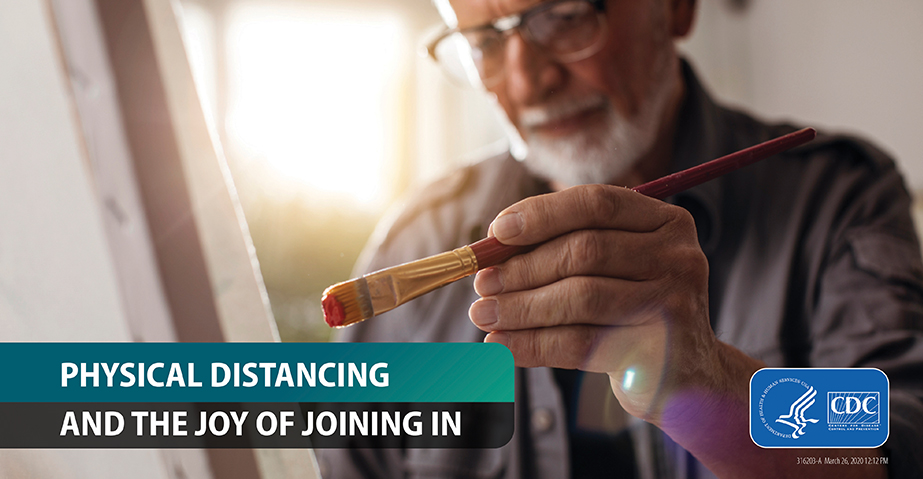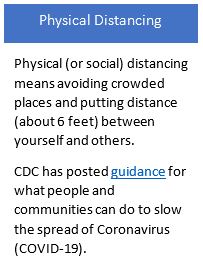Physical Distancing & the Joy of Joining In
Posted on by

Physical distancing is the act of avoiding crowded places and putting space between yourself and others. In practical terms, it means staying at home (mostly) and away from public places, such as restaurants, where people get together.
It’s a prescription that goes double for people who are at higher risk of getting very sick from this illness: older adults and people who have severe underlying chronic medical conditions like heart disease, diabetes, and lung disease.
Community Nonpharmaceutical Interventions
Community nonpharmaceutical intervention (or NPIs) are strategies used to help slow the spread of an infectious disease like COVID-19. The most common of these are physical distancing and closures, including the temporary closing of places and canceling of events that attract large crowds.
The goal of community NPIs is to slow the spread and reduce the impact of disease on public health and healthcare systems.
The rationale for using NPIs is that the slower the spread of the disease, the fewer people who are sick at any given time, and the better the care that sick people get, the better the outcomes.
Find the Joy of Joining In
At a time when physical distancing and closures are the new normal, how can people get past the “fear of missing out” feeling?
Rather than focus on what you’re missing out, try to find the Joy of Joining In on physical distancing and the opportunities it presents.
The Internet and social media can be a place of misinformation and stigma, but also of hope (e.g., quarantined Italians singing from balconies), resilience (e.g., an elderly couple ‘cruising’ in their living room), humor (a hamster taking everyday protective actions), and good ideas if you know where to look.
Here are 10 ways you and your family can also make the best of a bad situation.
- Read or listen to a book.
- Take a walk outside. Some state and local parks have waived fees.
- Download, photocopy, and share free Ready Wrigley activity books on topics, such as winter weather, hurricane, and tornado preparedness.
- Try out a new recipe out of your favorite cookbook or submit one to the Emergency Kit Cook-Off.
- Play a board game, put together a puzzle, or learn a new card game, such as FEMA’s Ready 2 Help.
- Do some spring cleaning around the house or weeding in the garden, or check things off the “honey do” list.
- Take a virtual tours of art museums and zoos, such as:
- Louvre Museum in Paris, France
- Uffizi Gallery in Florence, Italy
- National Gallery of Art in Washington, D.C.
- Guggenheim Museum in New York
- The San Diego Zoo
- Monterey Bay Aquarium in Monterey, Calif.
- Call, text, and video chat with family and friends; especially, older adults and people who have serious underlying medical conditions. Connecting with others can help reduce stress and anxiety in yourself and others.
- Do arts and crafts, such as coloring pages and paint-by-number projects, at home with the kids.
- Perform science experiments. The Internet is full of instructions for making everything from rock candy to a lava lamp.
For more information on how to prepare and protect yourself from COVID-19, please visit https://www.cdc.gov/coronavirus/2019-ncov/index.html.
References
- Resources for Large Community Events & Mass Gatherings (CDC)
- How to Protect Yourself (CDC)
- Manage Anxiety and Stress (CDC)
Thanks in advance for your questions and comments on this Public Health Matters post. Please note that the CDC does not give personal medical advice. If you are concerned you have a disease or condition, talk to your doctor.
Have a question for CDC? CDC-INFO (http://www.cdc.gov/cdc-info/index.html) offers live agents by phone and email to help you find the latest, reliable, and science-based health information on more than 750 health topics.
Posted on by

